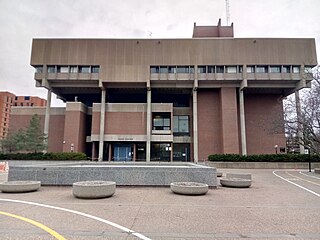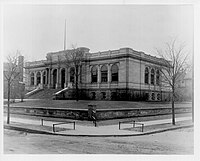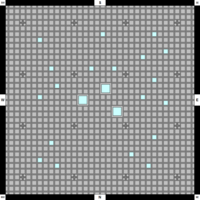
Ralph Rapson was Head of the School of Architecture at the University of Minnesota for 30 years. He was one of the world's oldest practicing architects at his death at age 93, and also one of the most prolific. He was the father of philanthropist Rip Rapson.
Nicollet Mall is a twelve-block portion of Nicollet Avenue running through downtown Minneapolis, Minnesota, United States. It is the shopping and dining district of the city, and also a pedestrian mall and transit mall. Along with Hennepin Avenue to the west, Nicollet Mall forms the cultural and commercial center of Minneapolis.

The Minneapolis Public Library (MPL) was a library system that served the residents of Minneapolis, Minnesota in the United States. It was founded in 1885 with the establishment of the Minneapolis Library Board by an amendment to the Minneapolis City Charter. Lumber baron and philanthropist T. B. Walker and other city leaders such as Thomas Lowry were members of the first library board. In 2008, after some financial difficulties, the library was merged into the Hennepin County Library system. At the time of its merger, the library included Central Library in downtown Minneapolis and fourteen branch libraries. Its collection numbered about 3.1 million items with about 2.2 million of these housed in the central library.

The Federal Reserve Bank of Minneapolis, located in Minneapolis, Minnesota, in the United States, covers the 9th District of the Federal Reserve, which is made up of Minnesota, Montana, North and South Dakota, northwestern Wisconsin, and the Upper Peninsula of Michigan. Although its geographical territory is the third largest of the 12 Federal Reserve banks, it serves the smallest population base of the system. It has one branch, which is in Helena, Montana.

The Hennepin County Law Library is a law library located in Minneapolis, Minnesota, founded in 1883.

Hennepin County Library is a public library system serving Hennepin County, Minnesota, US. The current iteration of Hennepin County Library was formed by the merger of urban Minneapolis Public Library and suburban Hennepin County Library on January 1, 2008. The system has 41 library locations, deposit collections at nursing homes and correctional facilities, mail service to the homebound, and extensive outreach services. The library is a department of Hennepin County Government. The library headquarters are in the Ridgedale Library in suburban Minnetonka. The library system has an eleven-member advisory Library Board appointed by the Hennepin County Board of Commissioners. It is a member of the Metropolitan Library Service Agency, a consortium of eight Twin Cities library systems.

Nokomis Library, formerly Nokomis Community Library, is a branch library serving the Nokomis East area of Minneapolis, Minnesota. One of 41 libraries in the Hennepin County Library system, Nokomis was designed by Buetow and Associates, Inc and opened in 1968 as a replacement for the nearby Longfellow Community Library. After being deemed crowded and outdated in 1999, the library underwent a renovation beginning in 2009 that saw it gain a number of environmentally friendly features and an expansion of 4,300 square feet (399 m2). The building reopened in 2011 and includes a restored Wind and Water Chime, a stabile that was part of the original library and that was refurbished and reinstalled by July 2013. The library contains over 35 computers, a public meeting room, and a Spanish-language collection of materials.

Sumner Library is a neighborhood library located in the Near-north neighborhood of Minneapolis, Minnesota, United States. Originally part of the Minneapolis Public Library, it became part of the merged Hennepin County Library in 2008. The Carnegie Library was a haven for Jewish immigrants to the city in the early 20th century. The Minneapolis Public Library moved its entire collection of Yiddish and Hebrew works to the branch library in response to a survey showing that 95% of the patrons were Jewish immigrants, some of whom learned English there and participated in social clubs in the building. The Tudor Revival building is listed on the National Register of Historic Places.

The Minneapolis Public Library, North Branch building is a former library in Minneapolis, Minnesota, United States. It was designed in 1893 by architect Frederick Corser. When it was opened, it was claimed to be the nation's first branch library to have open shelves so patrons could browse for books on their own, without asking librarians to retrieve them. The library set a precedent for future library development in the Minneapolis Public Library system.

Franklin Library is a public library on Franklin Avenue in Minneapolis, Minnesota, United States. The library was one of thirteen branch libraries established under the leadership of Gratia Countryman, the chief librarian of the Minneapolis Public Library from 1904 to 1936. The library housed the largest collection of Scandinavian books, newspapers, and magazines within the system, which reflected the population living in the area. The library was funded by the Carnegie Corporation and designed by Edward Lippincott Tilton, a New York City architect.

Walker Library is a public library in the East Isles neighborhood of Minneapolis, Minnesota, United States. It is on Hennepin Avenue one block north of Lake Street, adjoining the Midtown Greenway.

LeRoy Sunderland Buffington (1847–1931) was an American architect from Minnesota who specialized in hotels, public and commercial buildings, churches, and residences. He was born September 22, 1847, in Cincinnati, Ohio. He studied architecture and engineering at the University of Cincinnati and graduated in 1869. He later moved to Saint Paul, becoming a partner of Abraham Radcliffe, and worked on the remodeling of the original Minnesota State Capitol. After the first capitol burned down, Buffington designed a replacement that served as the State House until 1904. In 1881 he claimed to have invented the method of building skyscrapers using load-bearing iron frames. He applied for a patent in November 1887 and received it in May 1888. Even though many subsequent builders used this method of construction, Buffington was mostly unsuccessful in collecting royalties from his patent. Buffington remained in private practice in Minneapolis until his death on February 15, 1931.

Arvonne Skelton Fraser was an American women's rights advocate and political campaigner. She held the position of Senior Fellow at the Humphrey Institute of Public Affairs, University of Minnesota, and from 1993 to 1994 was the U.S. Ambassador to the United Nations Commission on the Status of Women. She also managed the political campaigns of her husband Donald M. Fraser during his career, from 1954 to 1979.

Pierre Bottineau Library is a branch library located in northeast Minneapolis, Minnesota, United States. It was named for Pierre Bottineau, a prominent Minnesota frontiersman and is one of 41 libraries in the Hennepin County Library System. The library moved to its current location at the historic Grain Belt campus in 2003. The 12,355-square-foot (1,147.8 m2) facility combines two historic buildings, the 1893 Wagon Shed and the 1913 Millwright Shop, with an addition designed by RSP Architects.

Northeast Library is a public library in Minneapolis, Minnesota, United States. It is part of the Hennepin County Library system. Since opening in 1973, Northeast Library at 2200 Central Avenue Northeast in Minneapolis serves a vibrant metropolitan community, Northeast, Minneapolis. At 15,275 square feet, the space held about 30,000 books and featured a fireplace to welcome patrons in winter. The 1973 building was itself a replacement for a Carnegie library which was on the site from 1915 until 1972.
Augsburg Park Library is a public library in Richfield, Minnesota. A Richfield branch library of Hennepin County Library has existed in various buildings in since 1951.

The Rarig Center is a brutalist theater, television, radio, and classroom building on the University of Minnesota's campus in the West Bank neighborhood of Minneapolis, Minnesota, US. Designed by Ralph Rapson and built in 1971, the structure houses four theaters—a thrust, proscenium, theater in the round, and black box—as well as the studios for Radio K. An anchor for the University's West Bank Arts Quarter, the Rarig has been praised for its boldness and functionality but has also been described as "menacing".

Richard "Rip" Rapson is an American attorney and philanthropist serving as CEO of the Kresge Foundation. He began his career as a congressional aide to Donald M. Fraser during Fraser's last two terms in the United States House of Representatives. After attending Columbia Law School, Rapson joined the law firm of Leonard, Street & Deinard to practice law while also serving on the board of several organizations. In 1989, Fraser, who had become mayor of Minneapolis, appointed Rapson as his deputy mayor and, in 1993, Rapson unsuccessfully ran for mayor to succeed Fraser.

The Northrop Mall Historic District is a historic district located at the University of Minnesota's east bank campus in Minneapolis, Minnesota. It covers buildings along Northrop Mall and in the surrounding area. The district was found eligible to be listed on the National Register of Historic Places in 2006, and was officially added in January 2018. Most of the buildings are connected by the Gopher Way; a tunnel and skyway network providing easy and direct enclosed pedestrian access. The district is roughly bounded by Pillsbury Drive SE to the north, East River Parkway to the west, Union Street SE to the east, and Delaware Street SE to the south. It is located directly south of the University's Old Campus Historic District.






















